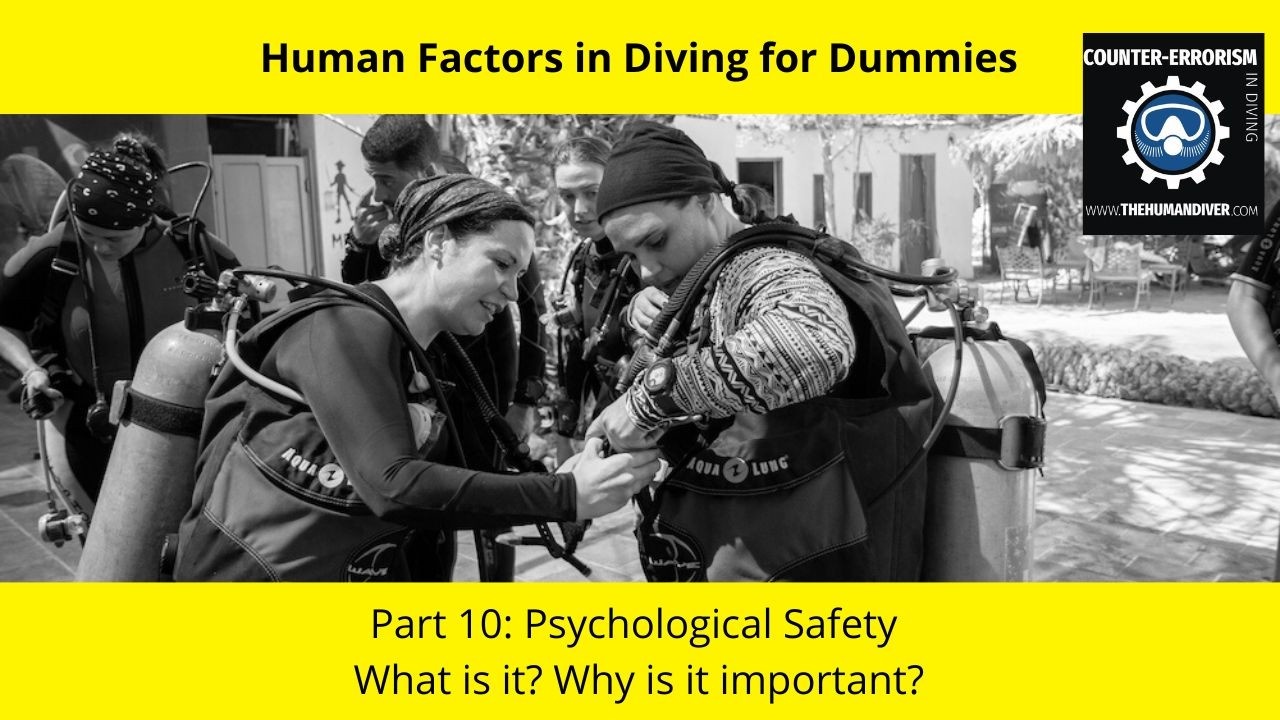
HF for Dummies: Part 10: Psychological Safety
Dec 04, 2022In a few of the other Dummies blogs, I mentioned Psychological Safety. What exactly is this and how can we develop it?
Psychological safety exists when a team can speak up about problems they’re having, knowing that they will be listened to and respected for speaking up, not shouted at or ignored. It is developed with trust, humility and good communication. It’s not something that can happen overnight and it can take a lot of work to build up but it’s the one defining feature of every high-performing team.
Trust
Trust is vital for psychological safety. If you don’t believe that you can speak up without getting shouted at, belittled, or worst of all, thrown out of the team, then there is no trust. Trust takes integrity and benevolence, as well as the belief that the person or people you’re diving with have the ability to do the dive. In other words, do you believe the rest of the team will do as they say they will (integrity) and that they aren’t just doing it for themselves but also for the benefit of others (benevolence)?

Humility
Humility means being humble. This doesn’t mean you aren’t confident but it does mean you can accept that you don’t know everything and aren’t the best at everything. It also means you listen to others both on your team and outside of it.
For good communication, we need to be open to working on our understanding of what people are telling us. It’s easy to make assumptions in conversations and we sometimes get these wrong, so we need to understand that it’s on the receiver of the information to check that we have a proper understanding of what the sender has told us. For more about communication, read this blog about it from the Dummies series.
Can I give you some feedback?
I was teaching a course recently and at the end of the course, I did my usual post-course debrief. This included getting the student to tell me what he thought were his strengths and what he needed to work more on (and how he was going to do that). When we finished, he very sheepishly looked at me and said “can I give you some feedback?”. I have known this student for quite a few years and trust that he will give me useful feedback. Our communication has always been straightforward and I have tried to make it clear that I am open to learning. He also trusts me enough to know that he could give feedback without me taking it badly. I’m glad that trust is there, as the feedback he gave me (that at times things had felt a bit rushed and as he was doing dives deeper than he’d been before, more time would have given him the chance to relax a little more and get in a better state of mind) was really useful. It is a very easy change for me to make and one that is worth doing if it helps my future students improve.

It goes both ways...
As shown by the example above, psychological safety goes both ways- to and from the leader and followers in a team, as well as with peers. However, it is the leader that normally will set the tone and a good leader will do their best to make sure that there is a culture of psychological safety within the team. This can be challenging at first as it takes courage to open yourself up, especially as humility is seen as a weakness by some people who don’t understand its value. A simple way to start out is by, as a leader, admitting to the team of a mistake that you have made. It doesn’t have to be anything huge, we all make tiny mistakes every day. Admitting to something as simple as “I misunderstood your hand signal” or “I forgot my weights” shows the team that you have humility- you are able to recognise that you make mistakes. It also shows them that it’s acceptable to share those mistakes, something that is really important as it allows everyone to learn from everyone else’s errors.
Summary
In summary, psychological safety has to be built on a foundation of trust, humility and good communication. These all take practice and admitting to your own mistakes is one of the easiest ways of starting to build it. When it exists, it is one of the strongest tools for a strong, high-performing team and you will quickly see the benefits.
Jenny is a full-time technical diving instructor. Prior to diving, she worked in outdoor education for 10 years teaching rock climbing, white water kayaking and canoeing, sailing, skiing, caving and cycling, among other sports. Her interest in team development started with outdoor education, using it as a tool to help people learn more about communication, planning and teamwork.
Since 2009 she has lived in Dahab, Egypt teaching SCUBA diving. She is now a technical instructor trainer for TDI, advanced trimix instructor, advanced mixed gas CCR diver and helitrox CCR instructor.
Jenny has supported a number of deep dives as part of H2O divers dive team and works as a safety diver in the stunt industry.
If you'd like to deepen your diving experience, consider taking the online introduction course which will change your attitude towards diving because safety is your perception, visit the website.
Want to learn more about this article or have questions? Contact us.











